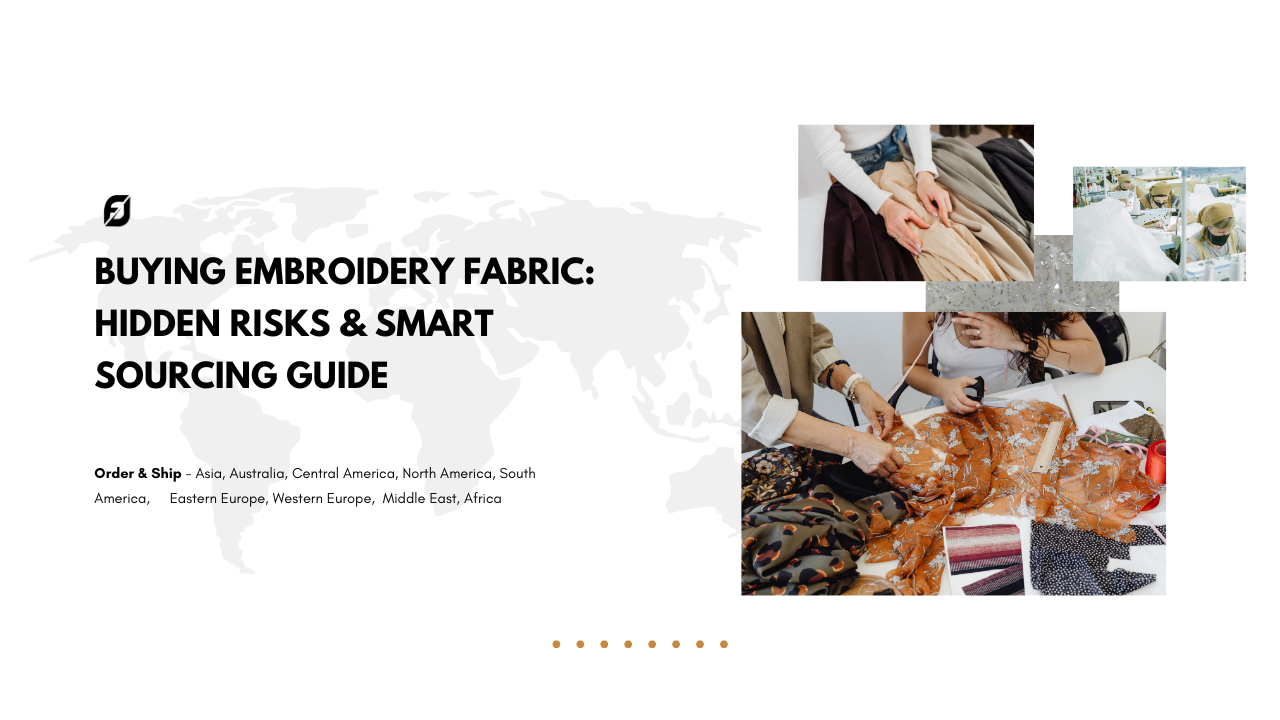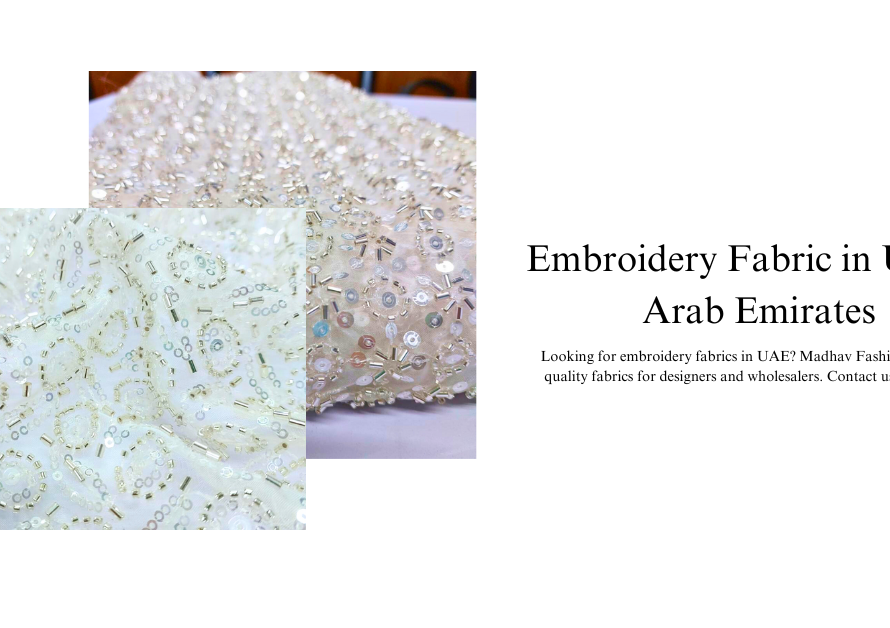Blouses, known by various names across the globe, hold a significant place in the world of fashion.
In India and some parts of the Gulf countries, the term “blouse” is widely used, whereas, in other regions, it might be referred to as a shell, bodice, bodysuit, middy, pullover, slipover, turtleneck, or by other names.
Embroidered Blouse fabric
This versatile garment, originally a loose shirt or tunic, is worn by both men and women and has evolved into numerous styles such as V-neck, overblouse, peasant blouse, camp shirt, camisole, sailor blouse, chemise, shift, and smock.
Origin and Evolution
The blouse has its roots deeply embedded in Indian culture, where it has been a staple of women’s attire since ancient times. Initially, the blouse was part of the traditional Indian sari ensemble, providing a modest yet elegant cover. Over the centuries, as trade and cultural exchanges flourished, the blouse evolved and adapted to various styles and purposes, spreading across the globe and being integrated into different cultures with unique variations.
Purpose and Usage
Traditionally, blouses served both functional and aesthetic purposes. They provided comfort and coverage, suitable for the hot and humid climate of India, while also allowing for intricate embroidery and embellishments that showcased the wearer’s status and artistry. Today, blouses are worn for various occasions ranging from daily wear to special events, and they can be simple or elaborately designed depending on the context.
The Rise of Embroidered Blouse Fabrics
Embroidered blouse fabrics have gained immense popularity due to their rich textures and intricate designs. These fabrics are not just confined to traditional attire but are also incorporated into modern fashion, making them a favorite among designers and fashion enthusiasts.
One of the leading names in the production of embroidered blouse fabrics is Madhav Fashion, reputed as the largest manufacturer in Asia. Madhav Fashion offers a wide range of designer premium embroidered fabrics that cater to various fashion needs. Their products are known for their superior quality and exquisite craftsmanship, making them a go-to choice for anyone seeking top-notch embroidered fabrics.
From their ancient origins in India to their global presence today, blouses have transformed significantly, adapting to cultural influences and fashion trends. Whether known as a blouse, shell, bodice, or any other name, this garment continues to be a versatile and essential piece of clothing in wardrobes worldwide. For those looking to add a touch of elegance with premium embroidered fabrics, Madhav Fashion stands out as a premier choice, providing beautifully designed fabrics that meet the highest standards of quality and style.
————————-
Frequently Asked Questions (FAQs) about Embroidered Blouse Fabrics
1. What is the origin of the blouse, and how has it evolved over time?
The blouse originated in ancient India as a staple garment for women, typically worn with saris. Initially, it was a simple, functional piece of clothing designed to provide comfort and modesty. Over time, the blouse evolved, influenced by various cultural exchanges and fashion trends. It spread to other regions and became known by different names, such as shell, bodice, and pullover. Today, blouses are worn globally in numerous styles, including V-neck, peasant blouse, and turtleneck. They can range from casual to formal attire, often featuring intricate embroidery and designs that reflect the wearer’s personality and cultural heritage.
2. What are the different names and styles of blouses around the world?
Blouses are known by many names and styles across different regions. In India and some Gulf countries, the term “blouse” is common. Elsewhere, they may be called shells, bodices, bodysuits, pullovers, or turtlenecks. Styles include the loose-fitting tunic, V-neck, overblouse, peasant blouse, and camp shirt. Each style offers a unique look and purpose, from casual wear to elegant evening attire. This diversity in names and styles underscores the blouse’s versatility as a garment, adaptable to various cultural contexts and fashion trends.
3. How are embroidered blouse fabrics made, and what makes them unique?
Embroidered blouse fabrics are made through a meticulous process that involves embellishing the fabric with decorative stitching. This can be done by hand or machine, with designs ranging from simple patterns to complex motifs. The uniqueness of embroidered blouse fabrics lies in their intricate designs and the skill required to create them. High-quality embroidery enhances the fabric’s aesthetic appeal, adding texture and dimension. These fabrics often reflect cultural heritage and artistry, making each piece unique and special. The choice of threads, colors, and patterns can vary, allowing for endless customization options.
4. What are the benefits of wearing an embroidered blouse?
Wearing an embroidered blouse offers several benefits. Firstly, the intricate designs add a touch of elegance and sophistication to any outfit, making it suitable for special occasions and formal events. Secondly, embroidered blouses often feature unique patterns that reflect cultural heritage and personal style. They are also versatile, as they can be paired with various bottoms, such as skirts, trousers, or saris. Additionally, high-quality embroidery enhances the durability and longevity of the fabric, ensuring that the blouse remains a cherished piece in your wardrobe for years to come.
5. What are the common fabrics used in making embroidered blouses?
Embroidered blouses can be made from a variety of fabrics, each offering different characteristics and benefits. Common fabrics include cotton, silk, chiffon, georgette, and velvet. Cotton is popular for its breathability and comfort, making it ideal for everyday wear. Silk and velvet are luxurious options often chosen for formal occasions due to their rich texture and sheen. Chiffon and georgette are lightweight and flowy, perfect for creating elegant, draped designs. The choice of fabric can affect the overall look and feel of the blouse, as well as its suitability for different seasons and events.
6. How do I care for and maintain my embroidered blouse?
Caring for an embroidered blouse requires special attention to preserve its intricate designs and fabric quality. Hand washing in cold water with a mild detergent is recommended to prevent damage to the embroidery. If machine washing is necessary, use a gentle cycle and place the blouse in a mesh laundry bag. Avoid wringing or twisting the fabric, as this can distort the embroidery. Air drying is preferred over machine drying to maintain the fabric’s integrity. When ironing, use a low heat setting and place a cloth over the embroidery to protect it from direct heat. Proper storage, such as hanging or folding in a cool, dry place, also helps in maintaining the blouse’s appearance.
7. Why should I choose Madhav Fashion for embroidered blouse fabrics?
Madhav Fashion is renowned as the largest manufacturer of embroidered blouse fabrics in Asia, offering a wide range of designer premium fabrics. Choosing Madhav Fashion ensures access to high-quality materials that are crafted with meticulous attention to detail and exquisite craftsmanship. Their extensive collection caters to various fashion needs, from traditional to contemporary styles. The company’s commitment to quality and innovation makes it a trusted name in the industry. Customers can expect unique designs, durability, and a perfect blend of tradition and modernity in each piece, making Madhav Fashion a preferred choice for embroidered blouse fabrics.
8. What are some popular embroidery techniques used in blouse fabrics?
Popular embroidery techniques used in blouse fabrics include Zardozi, Chikankari, Kantha, and Aari. Zardozi is a traditional Indian technique involving metallic threads, often used for elaborate designs. Chikankari, originating from Lucknow, features delicate, intricate patterns created with white thread on lightweight fabrics. Kantha embroidery, from West Bengal, uses simple running stitches to form beautiful motifs. Aari embroidery involves a hooked needle to create chain stitches, allowing for detailed and fine patterns. Each technique offers unique aesthetics and textures, contributing to the rich diversity of embroidered blouse fabrics available.
9. How can I incorporate an embroidered blouse into my wardrobe?
Incorporating an embroidered blouse into your wardrobe can enhance your style and add a touch of elegance. For a traditional look, pair it with a sari or lehenga. For a modern twist, team it with high-waisted trousers, skirts, or jeans. Mixing and matching different styles and fabrics can create unique outfits suitable for various occasions, from casual outings to formal events. An embroidered blouse can also be layered under blazers or jackets for a sophisticated look. Accessories such as statement jewelry or scarves can further elevate the ensemble, showcasing the blouse’s intricate designs and adding to your personal style.






